Ask any reasonably knowledgeable angler about where you can catch a cutthroat trout in Connecticut and you’ll be lucky if they can hold back a chuckle. To put it plainly, they don’t exist here. Despite the fact that a great many of the fish swimming in Connecticut waters today are introduced species that would’ve been absent from Southern New England when the Pilgrims landed at Plymouth about 400 years ago, there’s a broad and diverse array of trout, salmon and other related species –collectively termed “salmonids”- that can only be found elsewhere in North America or abroad. Bull trout, king salmon, arctic char, mountain whitefish, taimen: there’s all sorts of salmonids for which there isn’t a single specimen plying the waters of the Nutmeg State. If you want to catch any of those, you’ll have to travel to them. And cutthroat trout, a prized and emblematic species of the American West, is one such gamefish that no amount of hard work, wishful thinking or luck can materialize at the end of your line in the confines of Connecticut. But what if I told you that, for a few short years in the 1960s, that wasn’t the case? Indeed, not only were cutthroat trout living in Connecticut waters during those years, but bringing them to the net was arguably ordinary for anglers working the right water.
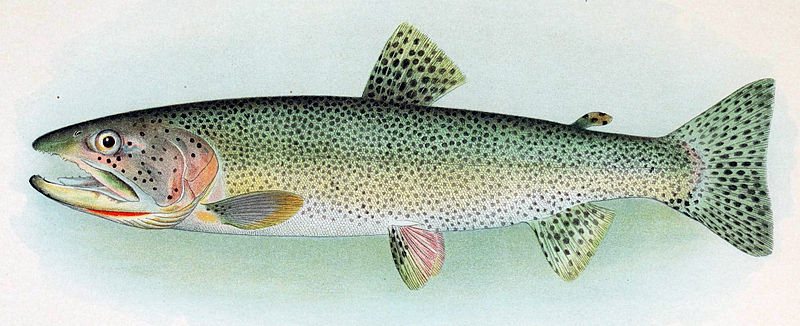
For thousands of years after the withdrawal of the great glaciers, the only salmonids native to Connecticut were the brook trout and the Atlantic salmon. And with Connecticut River strain of Atlantic salmon already well on their way to extinction by 1800 (remnant populations hung on for another handful of years),1 our salmonid fishery soon became monolithic: brookies, and only brookies, with the bulk of the populations living in relatively small and perennially-cool headwater streams where they persist to this day. But in the latter half of the 1800s, that began to change as the institution of the fish hatchery became firmly established. Species which Connecticut folks could only have dreamed of targeting close to home became not only a possibility, but in some cases, a common catch. Rainbow trout, native in North America only in the west, and brown trout, native to distant Europe, are easily the most recognizable imports today. But landlocked sockeye salmon, originally hailing from the Western reaches of the continent, still have a small presence here. And Lake trout, native to other nearby states, were a fairly popular introduced gamefish in Connecticut from the late 1800s through roughly the 1940s.
But the advent of hatchery rearing and stocking in Connecticut, and New England as a whole, has tended to almost completely overlook the cutthroat trout. One of the popular explanations offered is that habitat parameters in which cutthroat trout thrive are difficult to find in the wild east of the Mississippi. State hatchery managers in Maryland found that it was the hatchery itself in which cutthroats proved problematic, demonstrating lower survival rates over the course of rearing than rainbows and browns.2 But perhaps the simplest explanation is that, in spite of cutthroats being a sought-after gamefish among dedicated circles of anglers, they’re superficially similar enough to rainbow trout that most casual anglers in the East simply aren’t interested enough in a “lookalike” to warrant the cost and labor involved in rearing both species.
All the more fascinating then that, while sifting through the archives of Meriden’s Record-Journal, I happened upon an astonishing reference to cutthroat trout on April 21, 1960, buried on page 25 amidst notes about schoolie stripers on the Thames and perch fishing on Bantam Lake. “Greenfalls Reservoir, Voluntown, is providing good fishing for cutthroat trout, which were stocked experimentally as fingerings last fall”, the article states.3
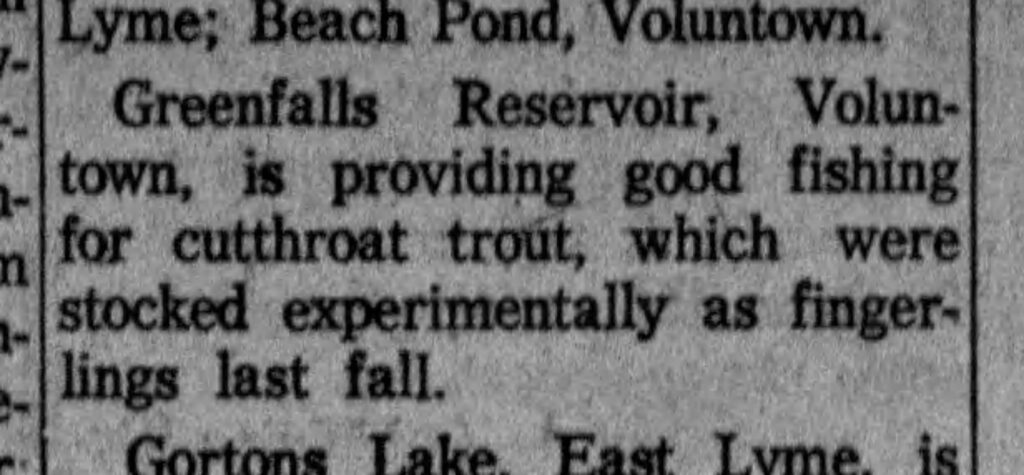
So far as I’ve been able to find, this was the first reference to the stocking of cutthroat trout in Connecticut published within a newspaper of broad circulation. And while the passage offers little in the way of details, there’s still plenty to unpack which helps us begin fleshing out the story of Connecticut’s cutthroat trout. For one thing, we can place the date of that first experimental stocking within Autumn 1959 (“last fall”). We can say that they were stocked not far from the Eastern border of the state in Green Fall Pond. And perhaps most intriguing, we learn that Connecticut residents were catching cutthroat trout in Connecticut water for the first time in history in Spring 1960! In fact, a Hartford Courant article published roughly a year later discussed the same stocking experiment and explicitly said as much. “Some [cutthroat] were taken last season,” the articles states,” believed to be the first of this species caught by fishermen in Connecticut waters.”4

That 1961 article mentions cutthroat trout almost as briefly as the earlier article, but nonetheless helps fill more gaps in an increasingly intriguing timeline. We learn that Lyme, a town along the terminal reaches of the Connecticut River, also received a stocking of cutthroat trout in Uncas Lake as part of that initial stocking effort in 1959. And the picture it paints of the effort appears promising. “Two small stockings of cut-throat trout, a Western species, showed encouraging results.” Indeed, that initial stocking was apparently considered at least successful enough that “tentative plans to do further experimental work with the trout” were in the works. But what would the next installment of this experiment entail?
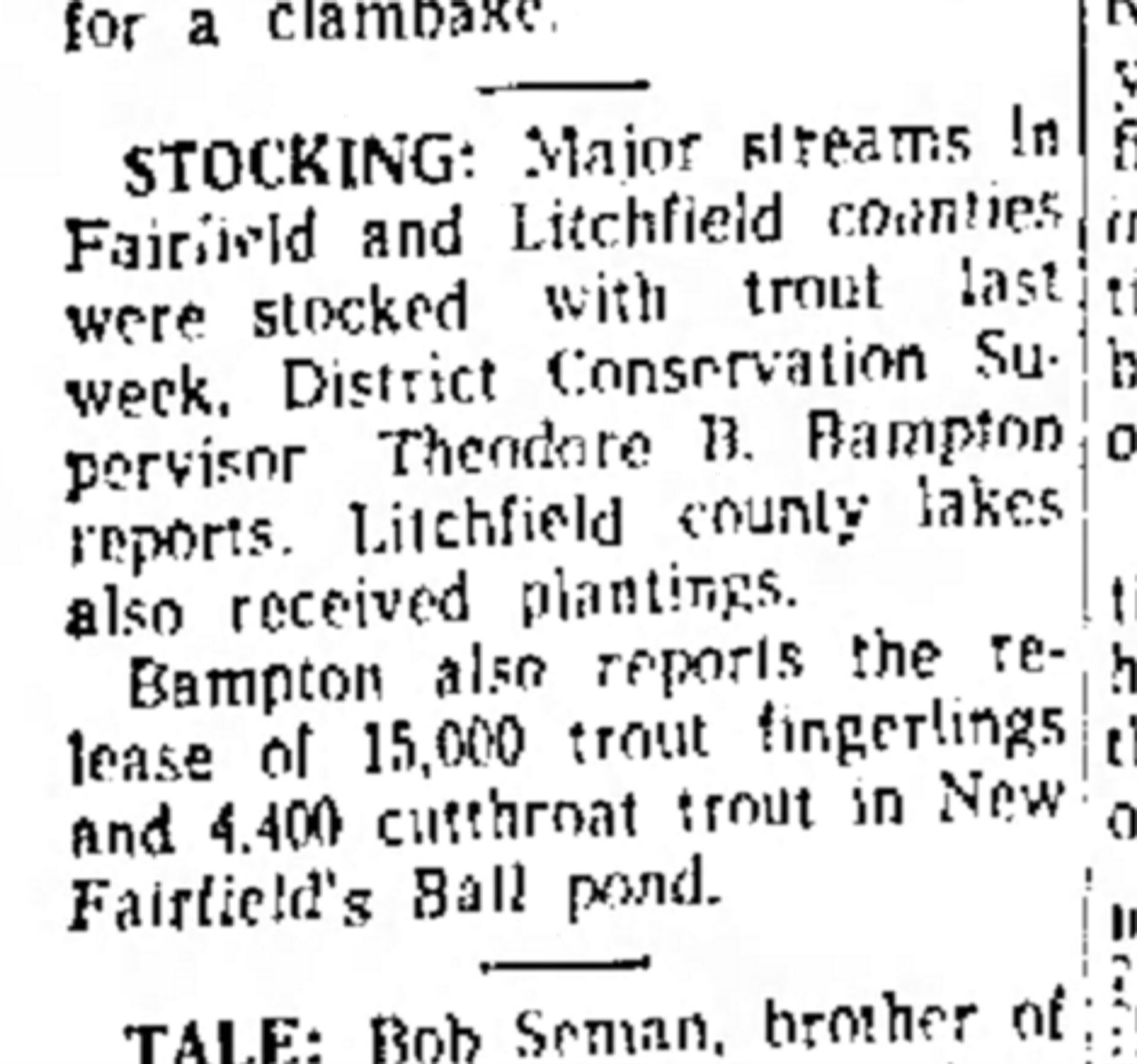
We get our answer the very next year from the Bridgeport Post in May of 1962 when the state’s District Conservation Supervisor reported “the release of… 4,400 cutthroat trout in New Fairfield’s Ball Pond.”5 The experiment had shifted from the eastern side of Connecticut to the Western borderlands near Candlewood Lake. And the volume of fish stocked, at more than 4,000, is hardly anything to sneeze at. After all, the latest modern stocking report I could find lists Ball Pond as having received about 2,500 trout in total during 2021.
But how did cutthroat trout do in this new lake? Suffice it to say, at least well enough that by 1963 folks were regularly landing them and refining the most productive approaches. The Bridgeport Record reported in June 1963, about a year after the stocking, that “trolling with small spoons is paying off in rainbows and cutthroats at New Fairfield’s Ball Pond.”6 That report came from one George Weldon, a boat livery operator on Ball at that time.
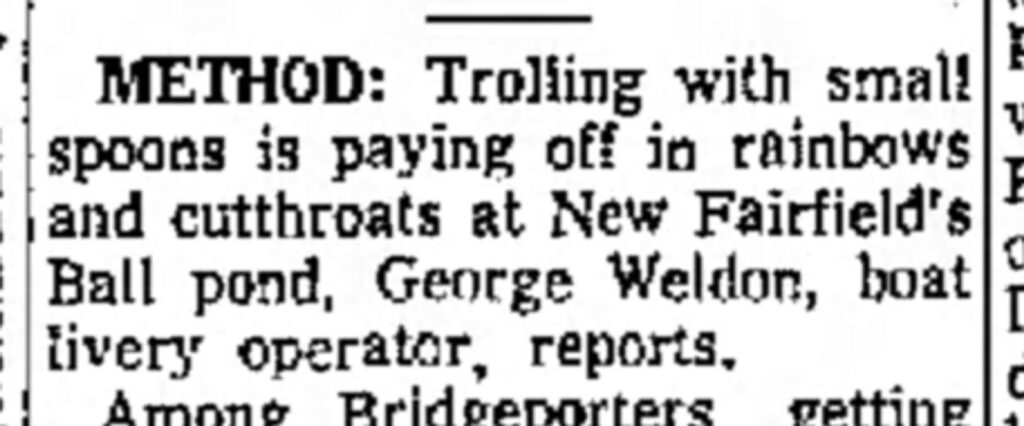
And for that matter, an article published just a month earlier in The Bridgeport Telegram finally gives us a glint of insight into the size of the cutthroats that were being caught. Ball Pond is mentioned as yielding “good rainbows, occasional cutthroat trout—one 15½ inches taken.”7 Considering that the cutthroats had only been placed in Ball a year earlier, a specimen of that size must’ve already been well over a foot long at the time of stocking. So while we’re never given any indication of the size of the cutthroats that were initially stocked in Ball, we can at least say that these certainly weren’t all 6″ fingerlings planted in hopes that they’d one day grow to a catchable size. No, some or all of these cutthroats were planted at an advanced enough age that they’d ideally be on the end of angler’s lines as soon as possible.
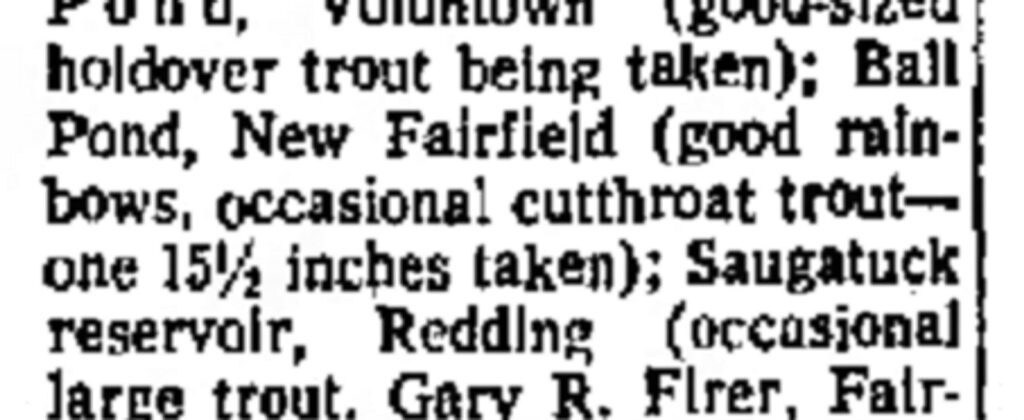
Judging purely by this handful of articles published between 1960 and 1963, it would seem as if cutthroat trout were well on their way toward gaining a more permanent foothold in Connecticut’s stocking program, even if maybe just in a limited series of waterbodies. After all, they had been placed in three lakes in three different locales in the state. All of these stockings yielded catchable fish which anglers were successfully targeting as interest in this new novelty species of trout grew. Even the state’s fishery personnel seemed at least enthusiastic enough about cutthroat trout to mention them to journalists or in informal press releases repeatedly.
And yet, this is where the trail abruptly goes cold. After June 1963, there doesn’t appear to have been any further mention of cutthroats in newspapers of broad circulation. We’re left to speculate that the experiments were discontinued after that 1962 stocking at Ball Pond and that, once the lingering survivors of that stocking were exhausted, cutthroat trout were once again absent from Connecticut’s waters. This hasty conclusion to our story leaves so many questions frustratingly unanswered, though. Where did the cutthroat trout for the stockings come from? What inspired state fisheries managers to conduct this experiment? And why was the experiment abandoned after just a few years despite yielding what would seem, at face value, to be relative success?
I wanted more answers, but clearly newspapers of the era weren’t going to be of any further help. With my fingers crossed, I sent an inquiry to Connecticut’s Department of Energy and Environmental Protection relating what I’d found and asking if they could possibly offer any insight that might help settle some of the mysteries that remained. My questions were directed to the Supervising Fisheries Biologist, Mike Beauchene, whom I’d remembered from occasional videos released online by the Fish and Game department and from a public input meeting on Connecticut trout fishing a number of years ago. Mike was eager to help and checked the agency’s files multiple times as I provided progressively more detailed timelines that could be used to direct more focused explorative efforts. But once all was said and done, a perplexing reality emerged: he couldn’t find anything. In fact, after a few attempts at digging up any relevant records and “re-scouring all of the bulletins that I have in that timeframe, plus or minus a couple years”, he concluded that he couldn’t “find one single reference to ‘cutthroat trout'”. The closest he’d found at all was a passing reference to “California trout” from 1884 and some stocking of “steelhead”, but these reports didn’t correlate in the least bit with our cutthroat stocking dates and referred to entirely unrelated efforts.
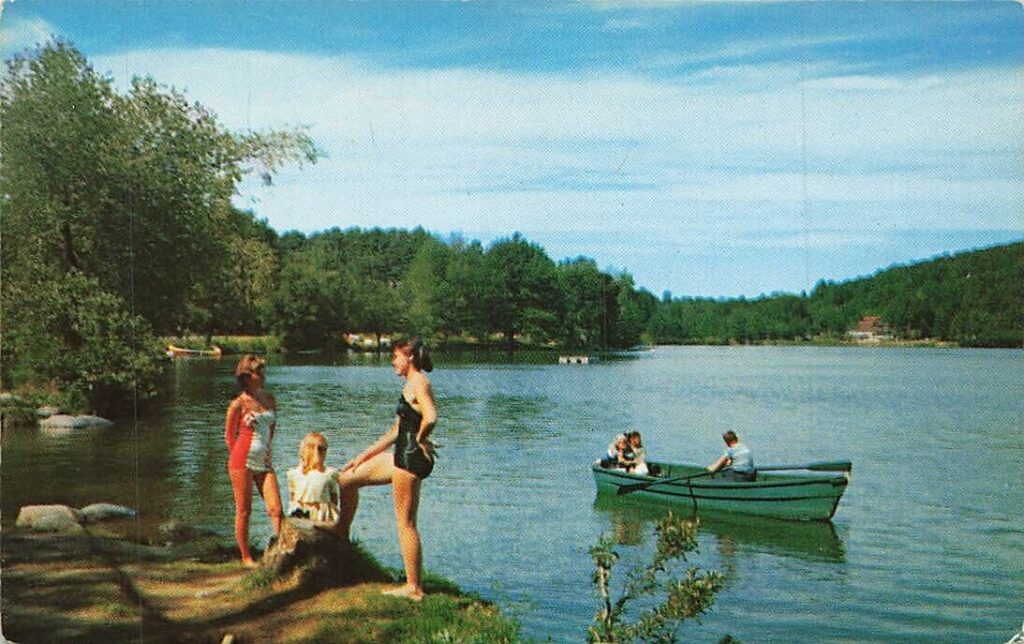
Appreciative of all his assistance, but admittedly unsure of what to make of a complete absence of state records related to a few years of cutthroat stocking, I inquired further. How were state fishery records kept going back 60 years? Were they generally just not filed away, or perhaps only kept for a short period of time and then discarded as a matter of course? Were they just lost over time as reams of documents were shifted from one cabinet or room to the next? “All of the above”, Mike explained. “Detailed records like invoices, stocking practices, and such are likely non-existent, being lost to time. What we do have are old published reports from 1866 on to about 1950. Then published ‘CT Wildlife Bulletins’ take over. Once we get into 1960-1970, records are a bit more stable and available.” So it would seem that Connecticut’s cutthroat trout experiment, running from 1959 through 1962, came right on the cusp of a more comprehensive era of documentation, but perhaps fell just a hair short.
Mike also offered one other possibility that I’d be remiss to exclude. “My personal opinion is that, because rainbow and cutthroat trout are very similar, the fish biologists may have either misused the name for the newspaper or they were using the name interchangeably.” He continued,” There is no real way to tell if true cutthroat trout were ever stocked in Connecticut.” Being of a questioning mindset myself, I can appreciate a healthy dose of skepticism and his point of view was worth consideration. Excessive eagerness to believe the unbelievable often breeds fools, after all. And admittedly, the fact that state records don’t contain even a single reference to cutthroat trout despite three supposed stockings is a troubling discovery for the veracity of the story I’d pieced together. Could it really have been that a handful of articles published over a mere handful of years were just mistakenly referring to cutthroat trout? Could the whole thing have been a big misunderstanding?
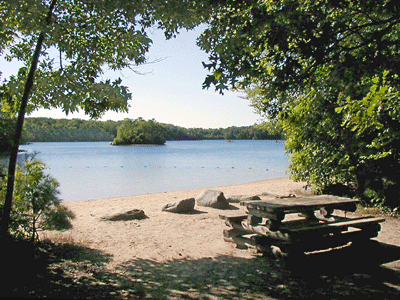
Affording the story all of the doubt that it’s due, I nonetheless think that we have more than sufficient circumstantial evidence to say with a good deal of certainty that cutthroat were, in fact, stocked in Connecticut and that all mentions of them in the newspapers of the time were accurate.
For one thing, in most of the articles in which cutthroat trout were mentioned, rainbow trout were also mentioned, so a deliberate distinction was being made within these articles which likely wouldn’t have been made if the term ‘cutthroat’ was just being used mistakenly to refer to rainbows. Instead, we would simply see entire articles in which rainbows were discussed as “cutthroats”. The 1963 article from the Bridgeport Post, for example, expressly states that “trolling with small spoons is paying off in rainbows and cutthroats at New Fairfield’s Ball Pond”, this being from the very mouth of the boat livery operator who would’ve had direct discussions with anglers regarding what they were catching out there. And for that matter, the individual that discussed the stocking of both rainbows and cutthroats with the Bridgeport Post in 1962 was none other than a state District Conservation Supervisor; not exactly someone who would be likely to idly swap species names on a whim, especially a species that would’ve had no prior, established place in the stocking program.
Furthermore, in multiple instances these articles expressly noted that the cutthroat stockings were “experimental”, a characterization that likely wouldn’t have occurred to anybody discussing rainbow trout stockings. The 1961 article from the Hartford Courant even goes out of its way to note that the cutthroat trout caught in 1960 were “believed to be the first of their kind caught in Connecticut waters”. Clearly, a number of very deliberate efforts were made, in more than one instance, to emphasize the uniqueness and novelty of these cutthroats in the context of Connecticut’s waters.
And finally, amidst the full range of articles we have discussing these cutthroat trout, there is distinct continuity over time in what information is available. Maybe we could reason that one article in one year could get terms or facts severely mixed up. But within the articles we have, at least one published each year for four years from 1960 through 1963, information stated about cutthroat in an article one year appears unfailingly to be corroborated during the following year in a subsequent article.
All of that taken together, it would be remarkable to me if the account of cutthroat stockings we glean from newspapers in the early 1960s amounted to so many accidental mix-ups, even if I must also concede that the absence of cutthroat from official state fishery bulletins is a problematic finding. I can only imagine that these short-lived cutthroat experiments involved such a relatively small volume of fish, and were of such secondary or novelty importance compared to the broader goals of fisheries managers at the time, that they just didn’t really warrant discussion in official bulletins. Certainly, it seems that even without being committed to bulletins, there was plenty of discussion about them which must have resulted either from direct discussion with fisheries personnel or less formal, long-lost press releases.8
But if cutthroat trout stocking was overshadowed by other state fishery concerns, we might naturally ask: what was the state fisheries department preoccupied with in the years during or leading up to those cutthroat stockings? And to that point, Mike was able to provide some fascinating records which may help shed light on why an experimental species like cutthroat might’ve been given a shot in Connecticut’s waters.
At least as early as the mid-1950s, state bulletins began describing heavy-handed efforts toward implementing a fisheries management strategy known as “reclamation” which was intended to re-engineer lakes for enhanced trout fishing. Waterbodies throughout the state were selected for reclamation based on fitting two criteria: they had to be conducive, at least in theory, to sustaining a population of trout, and the wild-born warmwater species that were already occurring there had to be of limited recreational value. As a November 1956 bulletin puts it, all lakes identified for reclamation were believed to be “best suited for trout management” and had hitherto “produced only mediocre to poor angling for warm-water species”.9
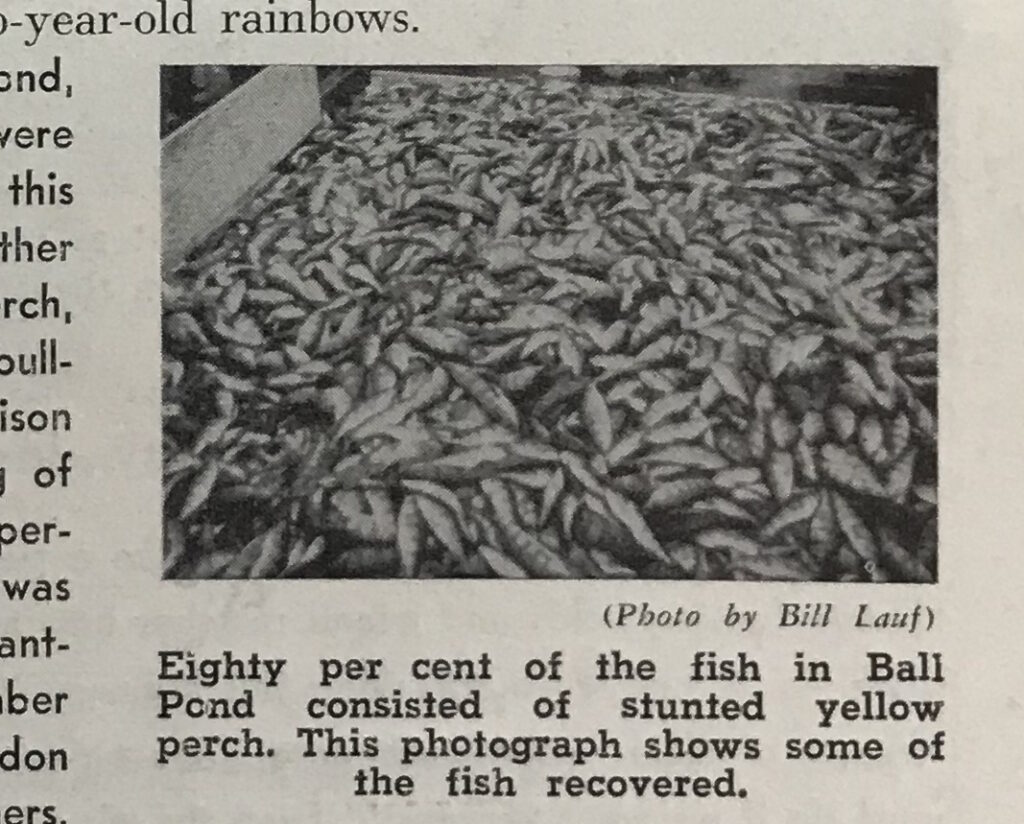
Reclamation itself was a severe and unsparing process in which the target lake was treated with rotenone, “a chemical suffocant” as it’s described, to fully exterminate the existing fish community. Afterwards, the dead fish (easily numbering many thousand in each lake if the photographs are any indication) would be removed, the rotenone would dissipate, and trout could subsequently be stocked in otherwise barren water free of competition. If all of this seems like a puzzlingly draconian way to approach trout management, it’s at least worth considering that the premise seemed sound enough at face value at the time, even if it grates against our modern sensibilities.
The March/April 1957 bulletin describes, in hard numbers, the key problem that fishery managers of the era were trying to solve. “Approximately 100,000… trout are being stocked annually in 53 lakes and ponds through the state…but it is probable that anglers recover less than 40,000,” explained fisheries biologists James Galligan and Cole Wilde. “This is due to the fact that trout are stocked in lakes that are inhabited by warm water fish, and being poor competitors, come out second best when they are forced to compete with these warm water fish for food and space.”10 Fully reclaiming select lakes from warmwater species should, by that logic, result in stocked trout growing larger, living longer and being significantly more likely to have an opportunity to serve their intended purpose of ultimately being caught by an angler.
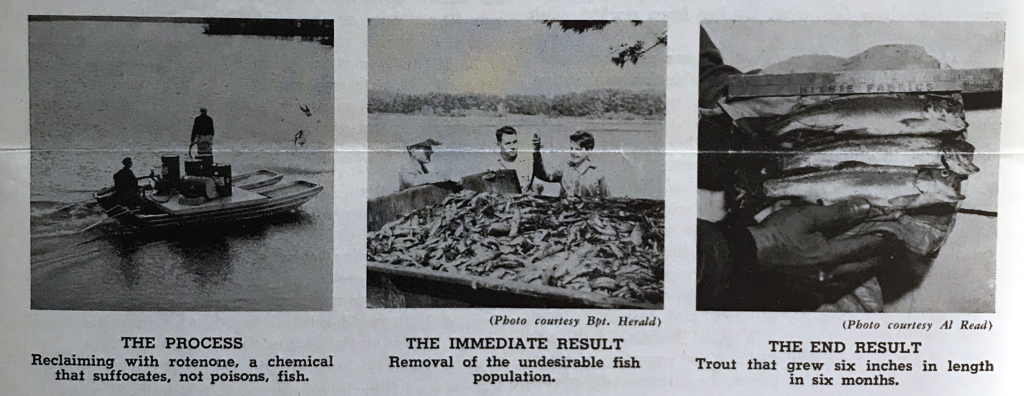
At the time, the state was very enthusiastic about the possibilities (even praising the reclamation tactic as “almost revolutionary” in a 1957 bulletin) and state literature frames the reclamation effort with great optimism and seemingly down-to-earth reasoning. But while I couldn’t find any literature produced by the state which retrospectively analyzed the actual degree of success realized through reclamation, it almost certainly proved to be far more effort than it was worth and the eventual abandonment of the tactic is no surprise. Of course, state fisheries managers were correct in surmising that larger predatory fish such as black bass, pickerel, and perhaps catfish do feed on stocked trout and, along with panfish, compete for food and resources. And those species are generally better suited to winning that competition in waterbodies where they’re found than are interloping coldwater trout species. But 70 years of subsequent research has made it clear that stocked trout face several difficulties after being released, with warmwater fish competition only being one facet. Lethal summertime water temperatures, hatchery-selected genetics and a sheltered hatchery upbringing all work against these fish after they’re turned lose in the wild. Further, the high density at which they may be planted means that stocked trout are likely subjected to aggressive competition amongst each other, too. Suffice it to say, reclamation may have made sense if the problems with stocked trout in most Connecticut ponds really did begin and end at competition with warmwater fish, but they don’t. It should come as no surprise then that reclamation is no longer a facet of Connecticut’s trout management strategies. We won’t even get into the egregious ecological concerns involved in the whole ordeal or the fact that warmwater species invariably seemed to find their way back into these lakes oftentimes in just a couple years.
But how does this short-lived experiment with reclamation relate to Connecticut’s similarly short-lived experiment with cutthroat trout? A column titled For Better Fishing, which appears in the Nov/Dec 1956 state bulletin, relates that the “Board of Fisheries and Game recently removed the fish populations from Norwich Pond, Uncas Lake, Mohawk Pond and Green Falls Reservoir” by way of reclamation. Both Uncas Lake and Green Falls stand out as being two of the three places where cutthroats would eventually be planted. A year later, the Nov/Dec 1957 bulletin announced that Fairfield’s Ball Pond had been reclaimed a few months earlier, making it “the ninth pond in the State to become a 100 per cent [sic] trout pond.” It even goes on to relate that “the public was invited to take as many [freshly killed] fish as it wanted” and that “George Weldon and Paul Britsch, boat livery owners, greatly helped the fish pick-up activity by permitting free use of their boats.” You might recall that George Weldon was the very same boat livery operator that, roughly 6 years later, would supply the report about cutthroats being caught on Ball Pond in 1963 which would be printed in the Bridgeport Post.
The state bulletin excerpts discussing reclamation that Mike sent along ranged from 1956 through 1958, and subsequent searching of newspaper archives revealed that the practice had been in place a few years earlier and probably continued a couple years afterward, as well. If nothing else, the account of these management efforts reveal that all three of the lakes where cutthroat trout would eventually be stocked had been brought into the state reclamation program in an ambitious effort to engineer them into ideal trout water. Surely, this would explain why the state fishery agency would’ve been open to exploring unusual opportunities at these waterbodies, such as the introduction of a previously untested salmonid. But whenever post-reclamation stocking efforts at the lakes were described in any sort of detail, only rainbow trout by the thousands are mentioned.
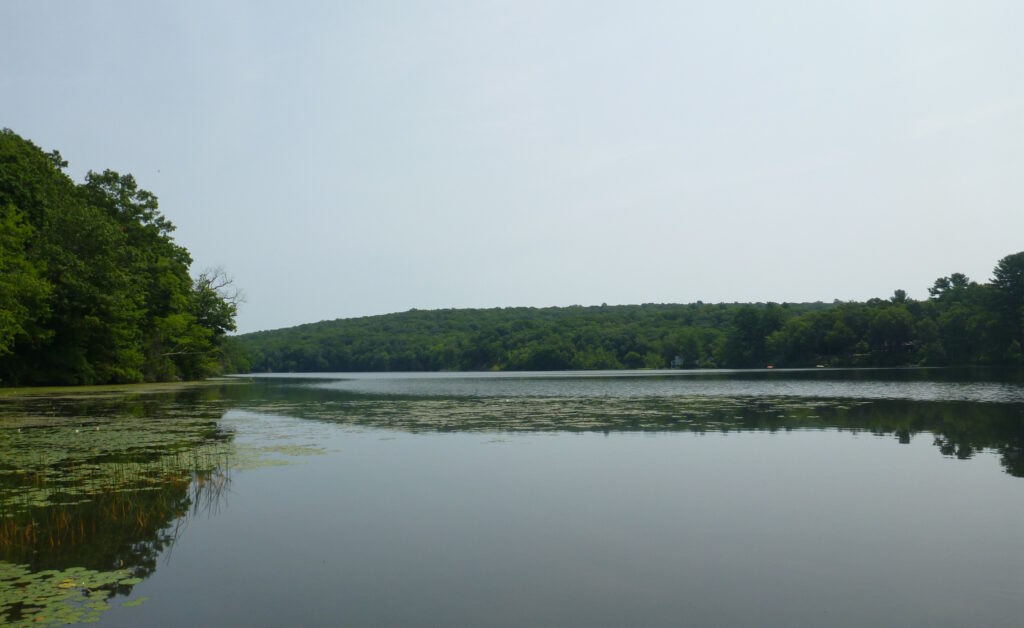
Having exhausted the available records, it seems likely that some elements of this unique experiment with cutthroat trout in Connecticut will forever remain a mystery. But in piecing together the fragmentary clues offered by state bulletins and newspaper articles, we can finally tell the long-lost story of Connecticut’s short-lived affair with an exotic trout from the West. Beginning in the mid 1950’s, Connecticut experimented with “reclamation”, an aggressive, heavy-handed management tactic intended to eradicate resident fish species in several warmwater lakes around the state and subsequently transform them into super-productive trout fisheries. A spin-off experiment was launched in 1959 in which, for the first time in the history of Connecticut’s waters, small stockings of cutthroat trout were placed in Green Falls Pond and Uncas Lake, probably as a limited, pilot effort to evaluate how the species might fare in these newly re-engineered habitats. At some point, likely in Spring 1960, an angler whose name has since been lost to time became the first to ever land a cutthroat trout in Connecticut at one of those two lakes. Others weren’t far behind and, with Ball Pond receiving its own experimental stocking of cutthroats in 1962, many more anglers would similarly find themselves reeling in a species that would’ve been unthinkable in Connecticut just a few years earlier. But that 1962 stocking would prove to be the last installment of the experiment. When anglers were still landing holdover cutthroats at Ball Pond in 1963, it’s likely those stocked in Greens Falls and Uncas in ’59 had already fizzled away. Rare two-year holdovers may have turned up in Ball Pond once in a while during 1964, but they were likely few and far between already, and it’s safe to speculate that Connecticut was once again devoid of Oncorhynchus clarkii by 1965. We’re unlikely to ever recover information about who devised the experiment, where the cutthroat came from, and the precise reasoning behind abandoning further trials. If the answers to those questions were ever formally recorded in state documentation, that literature has been lost. Though it may just as well be that, amidst the agency’s heavy workload and competing priorities, a trial run of cutthroat stockings amounted to a minor side-project and the time and labor that would’ve gone into committing an account of the experiment to the bulletins was perhaps better invested elsewhere.
Gardner wrote that “history never looks like history when you’re living through it.” And indeed, when it comes to something as arguably trivial to our practical lives as the stocking of an exotic trout in a few of Connecticut’s ponds, it’s understandable that the ordinary person would shrug in disinterest. But for those of us anglers who often have trout on our mind, or even just those who possess an insatiable curiosity of the past, the story of Connecticut’s cutthroat trout is an intriguing chapter in the bygone chronicles of our fishery, replete with an aire of mystery that makes us turn the tale over in our minds in wonderment of the unanswered questions that remain.
Do You Know More About Connecticut’s Cutthroats?
Folks were catching these experimental cutthroat trout roughly 60 years ago, so at least some anglers who targeted them (or who recall others doing so) are probably still around. If you know anybody who remembers fishing for these cutthroats at Green Falls Pond, Uncas Lake or Ball Pond between 1960 to 1963 (maybe as late as 1964 on Ball Pond), I’d be interested to hear about their experiences. Feel free to reach out at justin@jgcoleman.com. Note: As of January 10, 2024, just a few days after I released this article, I became aware that the contact email address I’d supplied was malfunctioning and emails sent there were never actually making it to me. As of January 11, I changed the contact email to one that’s definitely functioning correctly. If you tried to reach out over the last couple days, please give it a second try with this new address.
Acknowledgements
I’d like to offer a special thanks to CTDEEP Supervising Fisheries Biologist, Mike Beauchene, who went above and beyond in aiding me in my quest to learn more about these novel stocking efforts. Mike sifted through the available files multiple times and even went to the trouble of scanning several bulletins about reclamation.
References & Other Footnotes
- In my initial release of this article, I stated that Atlantic salmon were extinct before the 18th century. A reader challenged that claim and it prompted me to refresh my memory. While most sources do agree that the Connecticut River strain was already nearly extinguished by 1800, to my reader’s credit, instances of remnant populations appearing in the system are reported into the first decade of the 1800s. Consequently, this passage of the article was modified to reflect that a bit more accurately. JGC January 15, 2024. ↩︎
- Sawyers, M. A. (2009, June 27). Md. quit stocking cutthroat in 2007. Cumberland Times-News. It’s worth noting that Maryland seems to have started stocking cutthroat in a branch of the Potomac again after this article was published, though in my cursory research, it seems that the last stocking was back in 2018. For more authoritative information than what I was able to dig up, contact Maryland DNR. ↩︎
- Record-Journal, April 21, 1960, Page 25. ↩︎
- Hartford Courant, March 13, 1961, Page 19. ↩︎
- The Bridgeport Post, May 27, 1962, Page 48. ↩︎
- The Bridgeport Post, June 2, 1963, Page 68. ↩︎
- The Bridgeport Telegram, May 2, 1963, Page 21. ↩︎
- Some of the 1960-1963 newspaper article excerpts cited in this piece are echoed verbatim in other Connecticut newspapers printed on the same or similar date, possibly suggesting that the content of those articles was derived from press releases which have apparently been lost. ↩︎
- For Better Fishing. (1956). The Connecticut Wildlife Conservation Bulletin. ↩︎
- Galligan, J. P., & Wilde, C. W. (1957). Better Trout Fishing For Less Money. The Connecticut Wildlife Conservation Bulletin, 5–6. ↩︎
One reply on “The Lost Story of Cutthroat Trout in Connecticut”
Great article! While I don’t remember any cutthroat trout, I do remember Ball Pond being one of the “trout only” lakes. My father, brothers and I made a few special trips to Ball Pond in the late 60’s for trout – without much luck. I’m pretty sure that there was a prohibition against using live minnows as bait probably to prevent reintroduction of other species.